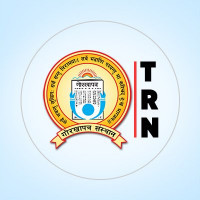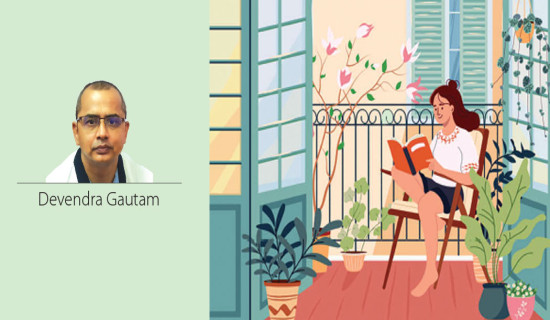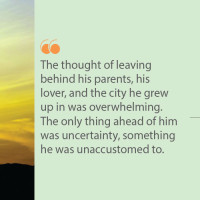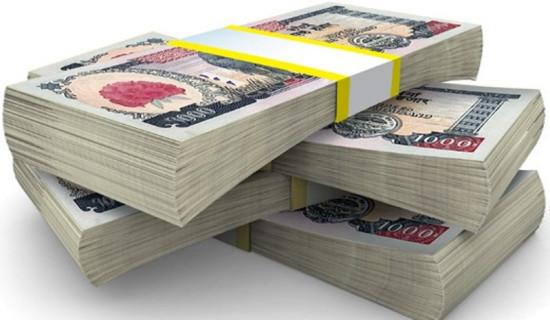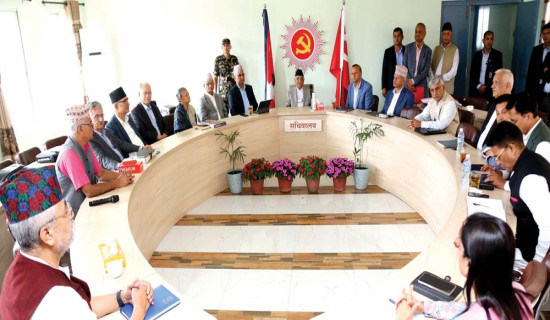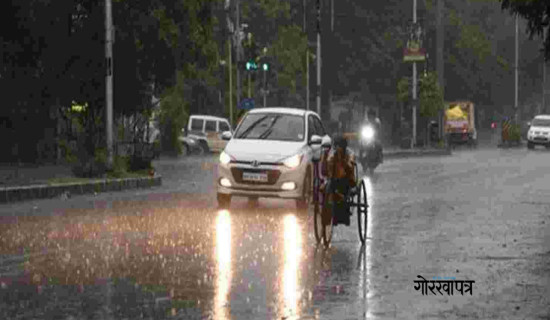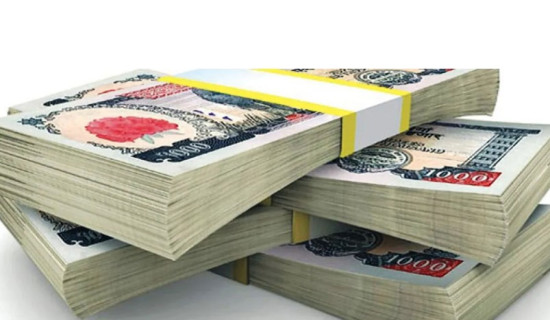- Friday, 18 July 2025
Alluring Chowks Of Hanumandhoka
Words fail to describe the splendour of the golden water spout at the centre of Mohankali Chowk inside Hanumandhoka Palace. Calling it a "water spout" would be a great act of injustice. But such is the cruelty of the English language that it does give us another word to refer to this ornately sublime conduit that makes one’s eyes water with its majesty. Blessed were the hands that carved this so-much-more-than-a-monument, blessed was every drop of water that had the privilege of flowing through this channel and blessed have been the eyes that have ever had the fortune of laying their gaze upon this masterpiece.
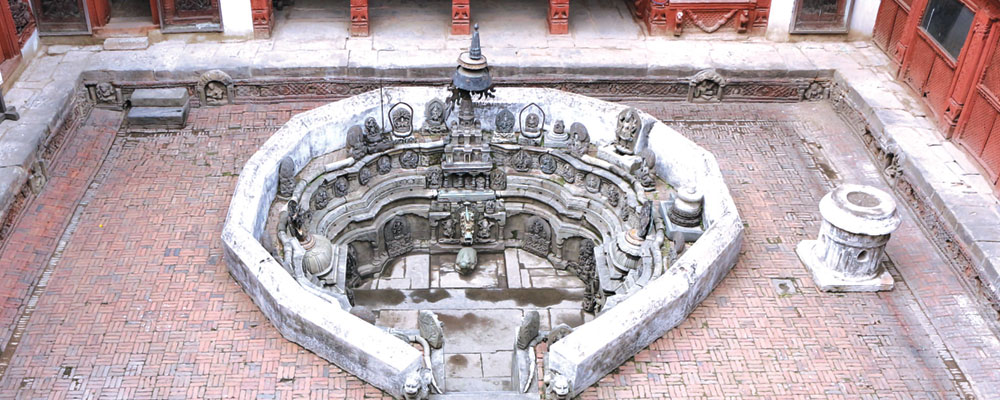
The nozzle of the spout is exquisite beyond words. Beasts, both mythical and worldly, gush out, rumbling and tumbling with the water that the spout brought from Budhanilkantha.
Immediately under the spout is an image of Bhagirath. Despite being carved into stone, the icon of the legendary man responsible for bringing the Ganga to the Earth feels alive; with his knees in his embrace, one can almost hear him contemplating everything he has seen over the centuries.
Built by Pratap Malla
Built by King Pratap Malla in 1649 AD as his living quarters, Mohankali Chowk is not just one courtyard among the 12 existing ones in the Hanumandhoka palace complex that would have been known as Layaku in his time. It is a living work of devotion and piety. The walls of the conduit and the surrounding buildings contain more than three dozen divinities. The western wing contains a monolithic life-size statue of Mohankali or the Astamatrika. The veranda of the building behind the spout has a golden canopy depicting gods and goddesses hung from the roof. The monarchs were supposedly brought here in the last moments of their lives so they could die under the wing of the very deities they lived their lives with.
Along the northern wall, there is a long inscription where Malla presents detailed guidelines on how to worship the gods and goddesses in his palace. Above the inscription are two rows of images – the first showing the ten avatars of Bishnu and the life of Krishna, and the second, the daily life of the people in Kathmandu’s kingdom. There are also images of a few “western-looking” people in this row intentionally inserted by Malla to boast of his international contacts.
The Chowk was also as tantrically powerful as it was aesthetically beautiful. Lore has it that every Malla son after Pratap had to be born here to be worthy of the throne. Jaya Prakash Malla was not and hence, lost his kingdom to Gorkhali conqueror Prithvi Narayan Shah.
This scribe found himself fully taken by the surreal ambience of the Chaukwath yard until he was rescued by his senior colleague Shrestha who, through her decades of work in reporting culture and heritage, had grown immune to the siren's song. Maya Devi Aryal, information officer at the Hanumandhoka Durbar Museum and a super-informative expert guiding the two journalists on their tour of the Rajkul, known as Gunpo or Gunapo before the Mallas, seemed equally invulnerable.
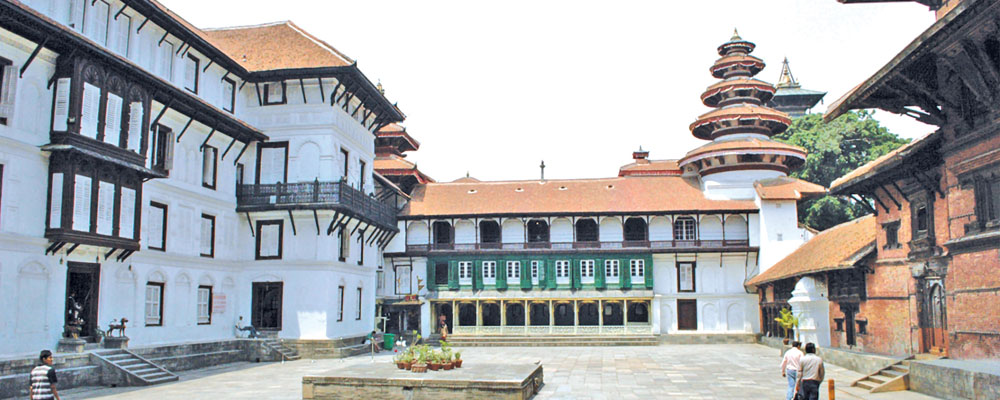
Aryal patiently took the two of us through a series of doors and passages connecting the various wings of this paradisiacal complex and led us to the rather immodestly named Sundari Chowk (Beautiful Courtyard). North of Mohankali, this is the smallest but one of the finest yards in the whole of Hanumandhoka. The wooden lattice windows and doors are hypnotic and give a glimpse into the magnum opus that this quadrangle must have been when it was inaugurated in 1650 AD, as per Hanumandhoka Durbar’s official website. Malla built this as both an extension and a replica of his Mohankali Chowk in the name of one of his favourite wives Rupmati, Aryal explained. That is why he spared no expense in making it as beautiful as he perceived Rupmati to be. One must spare a moment to truly appreciate just how stunning this section must have been for the monarch who presided over one of the most artistic states to have ever existed within the boundaries of modern-day Nepal to have christened it Sundari.
Golden Spout
This Chowk also contains a marvellous golden spout just like the Mohankali Chowk and opposite that in the Hiti Gaa is the most spectacular Kaliyadaman statue. “It is one of the finest specimens of devotional stone art not only in Nepal but all of South Asia,” Aryal said as she highlighted details as fine as Krishna’s nails and the wrinkles and the scales of the serpent demon Kaliya that the sculpture features.
It is a shame that no one knows who carved this representation of the suppression of Kaliya, why or when. From a thorough study of its features, Aryal hypothesised it to be a Lichhavi-era creation. King Pratap Malla supposedly found it at Sakona, present-day Lazimpat, and was so mesmerised by it that he broke royal protocol and brought it to the palace. At the time, kings were required to consecrate religious artefacts at the very place they found them but Malla was an avaricious soul so, he brought it and a Garud idol he found with it and installed them in the Sundari Chowk. However, misfortune befell on him and, ultimately, he was forced to let go of the Garud statue.
Mohankali and Sundari chowks are under renovation and are not currently open to the public at present. However, for ease of location, Sundari Chowk is the yard behind the 16-language black slab inscription visible on the outer wall of the Hanumandhoka Palace. The slab is a Jaladroni with a water tank behind it. When filled, water would flow out of the holes once present in the slab for thirsty wanderers to enjoy. And as they drank, they would also read the text scribed on the stone and be in awe of the linguistic dexterity of their king Malla, or at least, that was what he hoped when he made it.
Hanumandhoka Durbar gets its name from the red stone image of Hanuman guarding the main doorway (dhoka in Nepali) to the palace which today serves as the Hanumandhoka Durbar Museum. Right behind this door is a statue of Narsingh ripping open the abdomen of Hiranyakashipu. The dark statue, with golden ornaments and glowing white eyes, tells the tale of the religious fright that guided the state in the mediaeval era. Unfortunately, it is also a tale that transcends the scope of this article so perhaps, it would be best to explore it later.
For now, though, let us move ahead of this statue and feast our senses on the regality of the largest courtyard in the Hanumandhoka complex, the Nasal Chowk. Named after the Naasa Dya/Natyeshwor (a dancing form of Shiva) temple located on its eastern front, this Chowk is remembered by many as the site of the coronation of the Shah kings.
Sisa Baithak
It was originally built by the Mallas to be a square for public meetings, Aryal explained. The king used to sit behind glass on the patio, rather uninventively named the Sisa (Glass) Baithak, and his subjects, courtiers or foreign dignitaries used to stand in the yard and place their appeals. At times, it also served as a theatre for the performance of royal dances and state ballets, which is probably why the Natyeshwor temple was established here.
Nasal Chowk was not designed for crowning ceremonies so why then did the lavish Shah monarchs decide to use it for that? Well, it has to do with the day Prithvi Narayan Shah conquered Kathmandu, as mentioned in the aforementioned Hanumandhoka website set up by the Ministry of Culture, Tourism and Civil Aviation. Shah entered Kathmandu with his army on Indra Jatra, a day when a special representation of Indra is displayed on the raised platform of this Chowk. He saw this and felt that this Dabali was a special divine seat and thus, sought to proclaim himself king on it. None of his successors, up to the country’s last king Gyanendra, broke this tradition.
In the northeast corner of Nasal Chowk is the Panchamukhi Hanuman (five-faced Hanuman) temple, recognisable by its distinct five-storey circular design. And to the south is the nine-storey Basantapur Tower. This tower is one of four representing the four old cities of the Kathmandu Valley – Basantapur (Kathmandu), Kirtipur, Bhaktapur (Bilas) and Lalitpur (Laxmi Bilas) visible from the Lohan Chowk, the residential wing of the Shah kings.
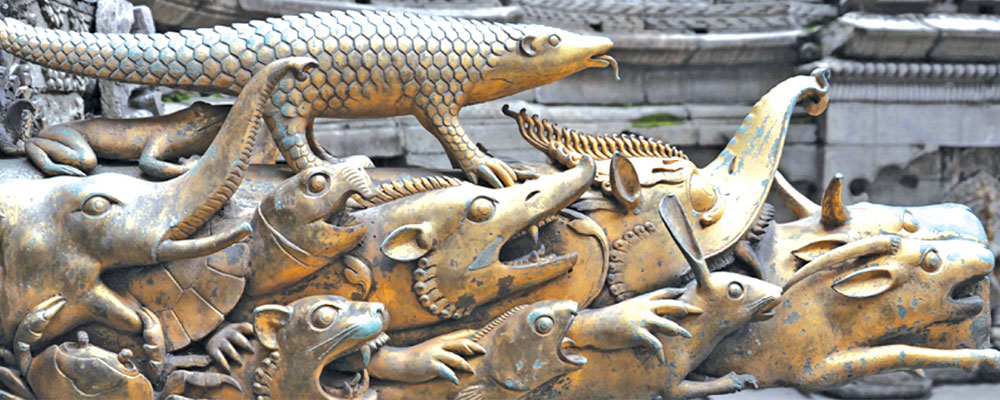
Lohan means stone in Nepal Bhasa and refers to a large slab at the centre of this yard. In this chowk, a much grander Chaukwath than Mohankali Chowk, the Mallas' artistic flair flows into the Shah's imposing exuberance as the state’s new master. Although the construction of these four towers is generally attributed to Prithvi Narayan, certain documents hint towards their existence, but in a much smaller form, before him. Similarly, Aryal shared that Prithvi was only able to complete Basantapur and Bilas towers and the other two were finished under the reign of his son Pratap Singh Shah.
And speaking of coronations, Mul Chowk was the courtyard used for the purpose during the Malla era. Built by Mahendra Malla in 1560 AD in almost a monastic style, according to Aryal, it was used for the principal (Mul in Nepali) religious ceremonies of the palace such as weddings, investitures of crown princes and the worship of the tutelary goddess Taleju. During the year’s two Dashains – Bada Dashain and Chaite Dashain – 54 buffaloes, goats and ducks are sacrificed here.
Mahendra Malla's Creation
Related to Mul Chowk is Trishul Chowk which was also built by Mahendra Malla in 1563 AD and named after the big stone Trishul (trident) erected at the base of the colossal Taleju Bhawani temple. In addition to being a space to pay homage to and evoke the power of the Bhawani, it was also a place for cultural performances as evidenced by the dabali here. The public can only access this yard on the ninth day of the Bada Dashain festival.
Bayu Chowk, Dashain Chowk, Dakh Chowk and Masan Chowk are four yards away, not as well known as the others. They are not listed in the Hanumandhoka Museum’s brochure and are off-limits to general visitors which is tragic because Bayu (Air) Chowk is one of the few places in Kathmandu that contains a temple solely dedicated to the god of winds and breath. Dashain Chowk has the royal Dashain house which, to this day, is where the state plants the sacred wheatgrass during the aforementioned festival following Vedic rituals that date back thousands of years. The Dakh in Dakh Chowk refers to a tropical variety of Bengali grapes that used to be planted here before the construction of the palace section. This is one of the blandest wings and only contains a cannon. Masan Chowk is an area of particular intrigue as its name implies that this was a royal crematorium. However, historical documents do not support this idea and the presence of Naasa Dya suggests that this quadrangle may have been a royal dance house. This chowk is also known as Kanhel Chowk because of the Karveer flower grown here. Kathmandu’s native name for Karveer is Kanhehol.
Nhula Chhen Chowk is another lesser-known part of Hanumandhoka. It is the first yard that Prithvi Narayan stepped into after he attacked Kathmandu and the place where he spent his first few nights in the city. His bedsheets are still preserved here. No one knows the exact date of this Chowk’s construction or what it originally looked like. It was “reconstructed” many times during the Rana era. This Chowk is also famous as the seat of the Kausi Toshakhana.
Library of Records
Hanumandhoka is not a single monument. It is a library that records the progress and regress of the state and statesmen from the Lichhavi era to the present day. Its monuments, icons and structures are some of the most majestic and divine in South Asia, if not the world. Unfortunately, much of it remains hidden from the people. Opening the palace up, with due rules in place in line with native cultural sensitivities, would serve to attract tourists and allow us to learn about our history and heritage. Guided tours and elaborations on artefacts and objects will also add to Durbar's charm.
(All photos used here have been obtained from Hanumandhoka Durbar Museum’s website: http://www.hanumandhokamuseum.gov.np)
(The writers are journalists who work at this daily)


